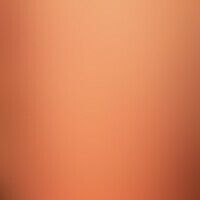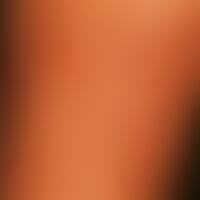Image diagnoses for "Nodules (<1cm)"
392 results with 1369 images
Results forNodules (<1cm)

Contagious mollusc B08.1
Small papular type of Mullusca contagiosa: focal sowing of small papular skin-coloured, smooth efflorescences reminiscent of verrucae planae juveniles; isomorphic irritant effect detectable.

Exclamation mark hairs L67.9
Alopecia areata : cadaveric (comedone-like aspect) and exclamation mark hairs (see below right).

Basal cell carcinoma (overview) C44.-
Nodular or nodular basal cell carcinoma: Relatively inconspicuous, non-symptomatic, red nodule with a smooth surface (see incident light image as inlet); the bizarre (tumor) vessels of the basal cell carcinoma become visible in incident light.

Granuloma annulare subcutaneum L92.0
Granuloma anulare subcutaneum. several, moderately pressure-dolent, skin-coloured to brown-red, deeply dermal or subcutaneously situated, moderately coarse, shifting, 0.4-1.5 cm large nodules and nodes. existence for years (5-15 years).

Granuloma anulare disseminatum L92.0
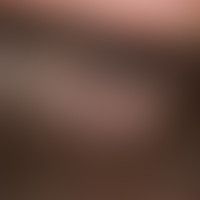
Lichen planus (overview) L43.-
Lichen planus of the capillitium: several atrophic plaques with discrete hair thinning.

Tinea inguinalis B35.6
Tinea inguinalis: plaques that have existed for several months, coarse lamellar scaling and moderately itchy. Mycological evidence of T. rubrum.

Acroangiodermatitis I87.2
Acroangiodermatitis. detail from the above figure. 0.2-0.4 cm large, initially isolated, then aggregated, deep red to reddish-livid papules develop from the smallest red (haemorrhagic) spots with a smooth surface, which finally confluent to form large plaques.
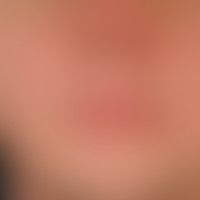
Acne papulopustulosa L70.9
Acne papulopustulosa: in acne-typical distribution, with large-pored skin, few red smooth and excoriated papules and some pustules.

Keratosis lichenoides chronica L85.8
Keratosis lichenoides chronica:Lichen-planus-like clinical picture with flat lichenoid plaques, on the forearm streaky excoriations due to distinct and permanent itching.
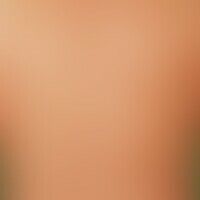
Xanthogranulomas adult (overview) D76.3
Xanthoma disseminatum: Overview with disseminated, symmetrically distributed asymptomatic papules.
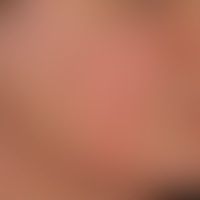
Demodex folliculitis B88.0
Demodex folliculitis: chronic bilateral follicular dermatitis with extensive reddening. Previous rosacea, but for months an unexpected significant worsening of the findings.

Becker's nevus D22.5
Becker nevus: extensive hyperpigmentation in the area of the right hip in a 7-year-old boy, existing since birth; section with emphasis on the follicles.

Lichen planus (overview) L43.-
Lichen planus actinicus: anularsmaller lesions and merged into larger map-like borderline plaques; in the prominent borderline area the violet shade of lichen "ruber" is found.

Melanoma cutaneous C43.-
Melanoma malignes: multiple cutaneous melanoma metastases in pre-operated nodular melanoma of the lower leg.

Dorsal cyst mucoid D21.1
Dorsal (mucoid) cyst. A photo collage of 4 photos.
Painless cyst (mucocyst) on the index finger, existing for about 1 year. An onychodystrophy, longitudinal depression is already visible due to the formation of nodules.
First picture: Before the operation. Anesthesia followed after Colonel, finger blockage.
Second image: A small ''window'' was opened to remove the cyst.
Third picture: After complete removal of the cyst, the window was closed and sutured shut.
Fourth picture: Post-op photo after 6 months. The picture shows the healthy grown (without deepening) nail, the pain has disappeared.

Lymphomatoids papulose C86.6
Lymphomatoid papulosis: Patient, 73 years of age. Within a few days a red, solid nodule appeared on the nasal wing. In the biopsy atypical dermal infiltrates with CD30-positive blasts. Within a few more days multiple similar nodules spread over the upper trunk.
At control 8 weeks after initial diagnosis the nodule at the nasal fossa is completely regressive leaving a milieu, but a new nodule 5 mm further cranially. The nodules at the trunk are regressive.

Scleromyxoedema L98.5
Scleromyxoedema: Multiple, symmetrically distributed, 0.1-0.2 cm large, roundish, non follicular papules with smooth, shiny surface.

Glossitis rhombica mediana K14.2
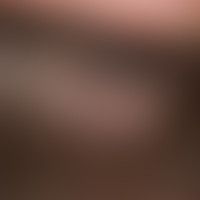
Lichen planus follicularis capillitii L66.1
Lichen planus follicularis capillitii: Increasing focal hair loss, reddish red with irregular, scarring alopecia (lack of follicular structure).

